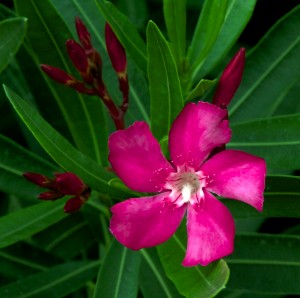Oleander (Nerium oleander) is a flowering shrub commonly seen in the Southern U.S. It is planted around motels, public buildings or along or in the median strips of roadways. Oleander is not native to the U.S., but there is controversy about its precise place or origin. Most authorities say it came from South or Southwest Asia. The name Oleander was apparently given because of some resemblance to the olive tree (genus Olea).
The plant is resistant to hot and dry conditions, is evergreen, and has attractive flowers. In the Fall, it produces elongated seed pods with many hairy seeds (see our Nature Notes 19, Winter, 2012 for some photographs). In the U.S. it can be grown outside as far north as Virginia. Oleander contains toxic cardiac glycosides, which can be fatal in high doses to humans, pets and livestock. However, very few cases of humans being poisoned by Oleander have ever been reported. Cases of Boy Scout troops being poisoned by eating hot dogs roasted using Oleander twigs as skewers are urban legends (http://www.snopes.com/horrors/poison/oleander.asp). At any rate one should be careful; no part of the plant should be ingested. Poisoning reportedly can also occur if one eats honey from bees that feed on Oleander nectar.
Many cultivars of Oleander have been produced by plant breeders, and flower colors other than the common red, pink, or white have been produced.

